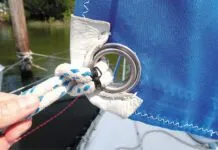Bad Balsa
The balsa core of my 1981 Morgan 46 has eroded from the area in the cockpit around the binnacle. It is rather localized.
The cockpit is directly over the engine room. Do you have any suggestions regarding the best method to attack repair? Should or can it be done from engine room up or must it be done from the top side down?
It is being suggested to me that I cut out the affected area of the cockpit floor, replace under that area, and then reinstall that piece.
For a cosmetic and complete job, it seems to me that if it must be done from the top down that it would be easier to cut out the entire cockpit floor, and then replace the entire core, and then refit the top deck with new glass and finish with gelcoat. It seems to me that having the cut-out seam around the perimeter of the cockpit would be far better looking than one in the middle. That approach strikes me as much simpler than doing a patch and the result should be far superior to a patch.
Does PS have any information or suggestions that might help me with this problem?
T.M. Wood
St. Louis, Missouri
If you have room to make the repair from the bottom side, you wont have to worry about the cosmetics on the topside. But glasswork performed upside down is always more difficult. And it sounds as though the engine might make access difficult.
From either side, we’d try hard to preserve one of the two skins.
If working from underneath, wed cut out the bottom skin of glass and remove the core in the affected area only, then replace the core and glass over with substantial overlaps onto the good surrounding areas.
If working from the top, how much of the cockpit floor you remove may depend on who is doing the work. A top glassman at a yard or builder can make that seam disappear and match the color of the gelcoat quite closely. In that case, he might elect to remove only the affected area. If you or a less experienced person is doing the work, youre right, it will be difficult to hide the seam (we know we couldnt, and we have tried), so removing the entire floor would make some sense, though there will still be a seam, just not as obvious. Still, youll have to glass the new floor on all four sides, going up the sides of the footwell, which wont look very pretty. Any new lamination will require overlaps and considerable fairing.
Understanding that we havent seen your boat, all things considered, wed try to repair just the punky area from underneath.
Exploding Ground Plates?
We have heard through the yachtie vine that Dynaplates-those lumps of copper and ? attached to ones hull-are great for SSB radios, but a potentially explosive device in the event of a lightning strike. We were told that the material literally detonates if a bolt from above of sufficient magnitude strikes the boat, leaving a significant hole for all that wet stuff to come poring through.
Is there any truth to this rumor? What alternatives might PS suggest to retain good SSB reception and feeling of greater security?
Doug & Dale Bruce
via e-mail
We have heard the same rumors that sintered bronze grounding plates can explode. The idea is that they have lots of porous areas to expose more surface area to ground than a solid plate. This helps them function better. The rumors claim that water inside these holes vaporizes when heated by lightning and can cause the plate to blow apart. We have never been able to substantiate these claims.
We had a Dynaplate on one of our boats when struck on the masthead by lightning. The plate transmitted the charge to ground and was not damaged.
Perhaps some failures have occurred. If so, we wouldnt be surprised to learn that the plate was small, or the electrical connection to it flawed. But even if one did explode, it wouldnt necessarily leave a hole in the boat. These plates are fastened by two bolts, which hopefully would remain intact, even if the external plate disappeared.
Considering that the American Boat & Yacht Council and various electrical authorities recommend ground plates, it seems unlikely that they are dangerous.
As for your SSB, a recommended method of providing the necessary ground plane is to lay in copper foil inside the hull. Before undertaking such an installation yourself, we recommend reading one of several good books on SSB-Mariners Guide to Single Sideband by Frederick Graves or Marine SSB Operation by J.M. Gale-or consult a marine electronics technician.
Readers who have had ground plates transmit lightning strikes are invited to comment.



































